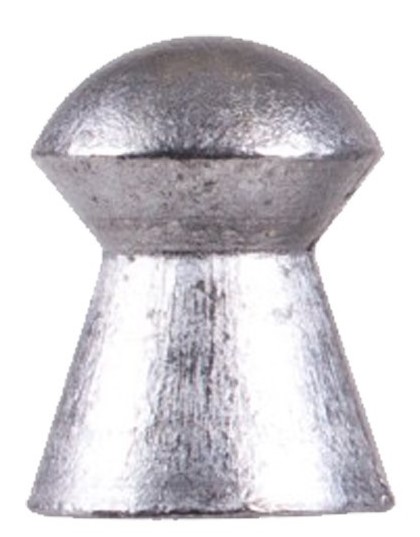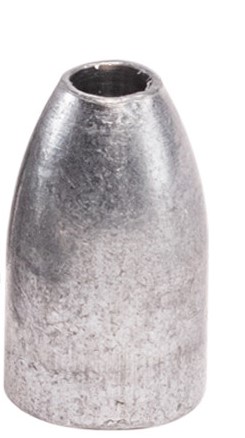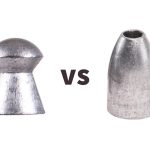Talk about a volatile topic; this is one of them. Slugs vs. pellets. Which is the better option and why? Well, it all comes down to the use. So let’s look at the how, when, where, and why for each.
Anatomy of a Pellet and Why it Works

Airguns shoot projectiles at a fraction of the velocity of a typical firearm. Additionally, many early airguns used smoothbore barrels vs. rifled barrels, which limited accuracy. Roundball ammo was not very accurate, so the pellet concept was born.
Most pellets are front-heavy with a narrow waist and a skirt that acts like the fletching of an arrow or feathers on a badminton shuttlecock. The idea is that the nose of the pellet, followed by the lighter flared “skirt,” would be more accurate. Adding a rifled and choked barrel further improved accuracy, and it’s been the standard setup for a long time. Get more details about the Anatomy of a Pellet.
Why Some Shooters Love Airgun Slugs

An airgun “slug” is nearly identical to a typical firearm bullet. They have a narrow nose for better aerodynamics (ballistics in our world), and there’s no waist or skirt to be found. Ideally, shooters need an unchoked, rifled airgun barrel for the best performance. When everything is working properly, slugs will retain their energy and velocity over a longer distance, making them ideal for long-range target shooting and hunting. Learn All About Ballistic Coefficient.
The Pellet’s “Downfall”
Pellets are still an exceptionally good option for target shooting and hunting with airguns, but they do have some significant disadvantages when you want to shoot longer distances. Because of their shape, there is a lot of resistance which causes them to lose velocity and energy very quickly. This has limited most pellets maximum effective range to inside 100 yards. Normally shooters would simply dial up the power for more velocity to overcome the poor ballistics. But that’s not the only problem. When you can get pellets going above the speed of sound, they are very accurate until they fall back below the speed of sound. This transition from supersonic to subsonic causes them to tumble, and all accuracy is lost. Given the physical limits of air as a propellant, pellets are most accurate when traveling around 900 FPS.
Slug Shortcomings
So if slugs are more stable and maintain their energy and velocity at longer ranges, why don’t folks just move to slugs across the board? Well, that long-range stability and accuracy comes at a high price. To achieve ballistic stability, slugs need to travel as fast or faster than pellets. In addition, airgun slugs are usually heavier than pellets, and their shape means more surface area dragging in the barrel. All this requires the airguns driving them to be much more powerful. Fortunately for those that wish to shoot slugs, many modern PCP airguns are up to the task.
Lastly, there are safety concerns. While some may see the limited range of pellets as a negative, it does mean that they are less likely to cause injury and property damage the further they fly. With slugs essentially being bullets without the gunpowder, their lethal range is much greater, creating some legitimate concerns when shooting in urban backyards.
Best Use for Pellets
It’s good that we have options that we previously did not enjoy. Pellets are affordable, accurate, and very backyard friendly. Let’s consider the best use case for pellets. Pellets are ideal for shooting targets and hunting game at shorter distances. Most modern airguns, even affordable ones, can shoot respectable groups at 50 yards. Highly specialized pellet guns can stretch that out to 100 yards, but those are few and far between. If you are a target shooter or hunter that shoots in their backyard or whose shots are mostly inside 50 yards, there’s no real advantage to shooting slugs. Pellets are the way to go.
Best Use for Slugs
If pellets are best for shooting close range, then it would make sense that slugs are best when you need to shoot farther out. And that’s exactly correct. Airgun slugs start to be more and more effective as you get past 50 yards. Because they have a better ballistic coefficient, they shoot flatter and retain their energy and velocity much better. Because they are heavier, they also give hunters an advantage on larger game, delivering more energy on target. So if you are hunting and shooting beyond 50 yards, then finding a good airgun slug for your needs is not a bad idea. Read this article for a head to head comparison of the Hades pellets vs Knockout slugs.
Final Thoughts
The debate over pellets and airgun slugs is far from over. The reality is that they both have their place in an airgunners toolkit. Check out all the airgun ammo options available to see what will work best for you. Pick the right tool for the job, always consider safety, and get out there and have some fun with your airgun.
